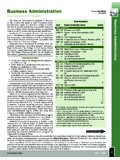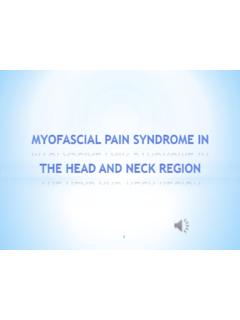Transcription of Sacroiliac Joint Dysfunction & Treatment - MCCC
1 A M Y H O Y E RSacroiliac JointDysfunction & TreatmentSacroiliac (SI) Joint Why is this going to be important to you? Some look at the SI Joint as either the end of the spine or the beginning of the lower extremity. Which way do you see it? Sacroiliac Joint SI Joint pain is a condition that affects 15% to 25% of patients with axial low back pain Largest axial Joint in the body Diarthrodial synovial Joint Designed primarily for stabilityFunctions of the SI Joint Transmission and dissipation of trunk loads to the lower extremity Limiting x-axis rotation Facilitating parturition (giving birth) Various types of motions: Gliding Rotation TiltingSI Joint Muscles Muscles are functionally connected to SI Joint ligaments, therefore their actions can affect Joint mobility Muscles involved.
2 Gluteus maximus and minimus Piriformis Biceps femoris Quadratus lumborum Erector spinaeSI Joint Ligaments SI ligamentous structure is extensive and functions as a connecting band between the sacrum and ilia Limit motions in all planes of movement These ligaments are weaker in womenSacroiliac JointLigamentFunctionSacrospinous and SacrotuberousResists forward tilting (nutation) of the sacrum on the hip bone during weight bearing of the vertebral columnInterosseousResistsanterior and inferior movement on the sacrum; strongest ligament supporting the SI jointPosterior (dorsal) sacroiliacResists backward tilting (counternutation) of the sacrum on the hip bone during weight bearing of the vertebral columnp.
3 44, DuttonPosterior ViewAnterior ViewAging of the SI Joint Changes begin in puberty and continue throughout life Adolescence Iliac surfaces becomes rougher, duller, coated in some areas with fibrous plaques 30 s 40 s Surface irregularities, crevice formation, clumping of chondrocytes 60 s Motion may become markedly restricted 80 s Erosions and plaque formation are inevitableMechanism of Injury Combination of axial loading and abrupt rotation Pathological changes affecting SI Joint structures Capsular or synovial disruption Capsular and ligamentous tension Hypomobility or hypermobility Extraneous compression or shearing forces Abnormal Joint mechanics Microfractures or macrofractures Soft tissue injury InflammationRisk Factors Leg length discrepancy Gait abnormalities Prolonged vigorous exercise Scoliosis Spinal fusion to the sacrum PregnancySI Joint Pain
4 Referral patterns for SI Joint pain: Radiation into the buttock Lower lumbar region Lower extremity Groin area Upper lumbar AbdomenSI Joint Pain Pain may worsen with: Riding in a car Weight bearing on the affected side Valsalva Forward flexion in standing position Pain may be relieved with: Weight bearing on non affected sideTreatment Widely acknowledged to be one of the most challenging problems Treatment modalities consist of: Physical therapy Orthotics SI Joint blocks Surgery Mobilization Treatments can be divided this way: Correcting the underlying pathology Alleviating symptomsPhysical Therapy Stretching and strengthening the weak muscles Pelvic stabilization Restoration of postural and dynamic muscle imbalances Correction of gait abnormalitiesFor more A great source of information on SI Joint Pain SI Joint Dysfunction Animation Tools One minute paper Touch on what stood out the most to you How much did you retain?
5 Presentation EvaluationReferences Cohen, (2005). Sacroiliac Joint Pain: A Comprehensive Review of Anatomy, Diagnosis, and Treatment . Anesthesia & Analgesia, 101, 1440-53. Dutton, Mark. (2011).Orthopaedics for the Physical Therapist Assistant. Massachusetts: Jones & Bartlett Learning. Slipman, , Whyte, , Chow, , Chou, L., Lenrow, D, Ellen, M. (2001). Sacroiliac Joint Syndrome. Pain Physician, 4, 143-152.









